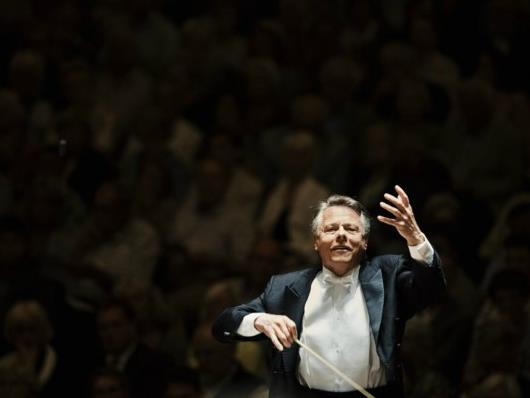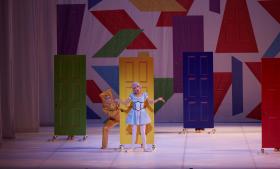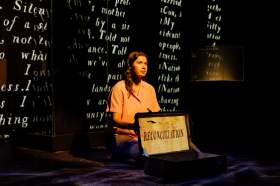Mariss Jansons. Photo by Anne Dokter.
I had a preview of this long-awaited and exciting performance – in my car, the night before I heard it in an excellent concert hall. Now, while the interior of a Mitsubishi is not an ideal sound space, it was clear that the Queensland audience was thoroughly enjoying hearing the Royal Concertgebouw Orchestra Amsterdam (RCO), along with listeners to ABC Classic FM all over the country.
However, nothing compares with live performance. As the capacity Hamer Hall audience waited for the arrival of the orchestra there was palpable excitement that exploded into loud cheers and clapping as soon as the musicians started filing on to the stage. This was amplified by the arrival of the distinguished conductor, Mariss Jansons, chief conductor of the RCO since 2004. But when he turned to face the large orchestra there was a hush.
The first work, a nod to the orchestra’s home, was by Dutch composer Johan Wagenaar. Born in 1862 he was a near contemporary of Richard Strauss and the RCO itself as it was established in 1888. Perhaps the best aspect of the Overture to The Taming of the Shrew was its opening chord. Strong and emphatic, it gave an immediate sense of the strength of the conductor and his relationship with the orchestra; throughout the night (from a close vantage point) I observed how even the most subtle gesture elicited an instant response from the 100 or so musicians in the RCO.
Wagenaar’s composition allowed for much more of the same, being a showy piece that highlighted aspects of the orchestra, such as its balance, its ability to deliver a lush waltz as easily as a ‘big finish’. But surely Jansons’ leap at the end could not have been in celebration of music that relied almost solely on showiness for its interest: perhaps he was looking forward to the next item, The Firebird Suite by Stravinsky.
This work features regularly in symphonic programs, and has everything going for it: imagination in both its story and composition, opportunity for different sections of the orchestra (including harps) to shine and, yes, plenty of fire. It begins ominously, with the pizzicato basses and drone-like cellos laying the path for the entry of trombones. The winds suggest the entry of the firebird and appear to dance through the strings in the variations that follow.
Very brief but sweet passages played first by the concertmaster, then lead cello, could easily have been lost in the swirl of sound, but Jansons was ready for every nuance of the music – and so we heard it. Notable was the way the lower strings later used a similar technique to the opening, but to entirely different effect – producing a languid, even luxurious sound. Flute, oboe and, later, bassoon parts expressed the firebird’s emotional journey (or sections that have nothing to do with that, such as the Round Dance of the Princesses).
The Finale as performed by the RCO was thrilling, ranging as it did from percussive elements to hushed tension to the final triumphant hymn. This second item in the program married brilliant performance with a well-loved piece of music, the trigger for the audience to shout, clap, whistle and stamp its feet in appreciation, with excited anticipation of the great work to come after interval.
Tchaikovsky’s Symphony No.5 in E minor, Opus 64 is so central to the orchestral repertoire that a reviewer should quail at the prospect of passing judgment on its structure, or even performance. As the orchestra tuned up for the second half, fragments of well-known motifs were heard, raising excited anticipation about hearing a world-famous orchestra play this epic work.
The Concertgebouw did not disappoint. But at close range it did impress, as the strenuous efforts of conductor and musicians could be seen to produce music of such beauty. Perhaps uncharacteristically for a work that is such a towering example of a Romantic symphony, the Fifth begins with an Andante – with an early introduction of the famous theme. However, there are wonderful contrasts as it progresses to the Allegro – a march, a waltz to introduce a new theme – and the orchestra more than delivered on the instruction “con anima”.
The cello section was augmented for this work and, with the upper strings comprising about half of the musicians on stage it showed, in the rich core of sound at the heart of the orchestra. To begin the second movement with Andante is more usual – but this was very different from the opening. It has quite a Slavic sound, with the French horn articulating the dominant, beautiful theme that is to lead eventually to a magnificent climax (and a great opportunity for the brass to ring out).
After the Valse, which is a brief but welcome reminder of Tchaikovsky the ballet composer, comes the Finale. Its complexity and demands on the orchestra make it almost like a symphony in itself – it has no less than four distinct sections. I am at a loss to describe this performance by Jansons and the RCO, it was so resonant and entirely satisfying. The conductor seemed to infuse the orchestra with passion and their excitement communicated itself very directly to a receptive audience.
We had expected no less from the Concertgebouw, but it was nevertheless thrilling to be swept away in this glorious music. My words could add little to the experience but I was not alone. The audience added a standing ovation to their applause and were given a spirited Dvorak encore – his Slavonic Dance No 1 in C. I would have happily listened to the whole of the Tchaikovsky all over again!
5 stars
__________________________
The Concertgebouw presents a program of Beethoven and R. Strauss at Hamer Hall tonight, and plays the two programs at the Sydney Opera House this weekend.
details at http://www.sydneyoperahouse.com/about/program_rco.aspx?gclid=CMn2gLSGhLsCFQdfpgodcWUAEQ





